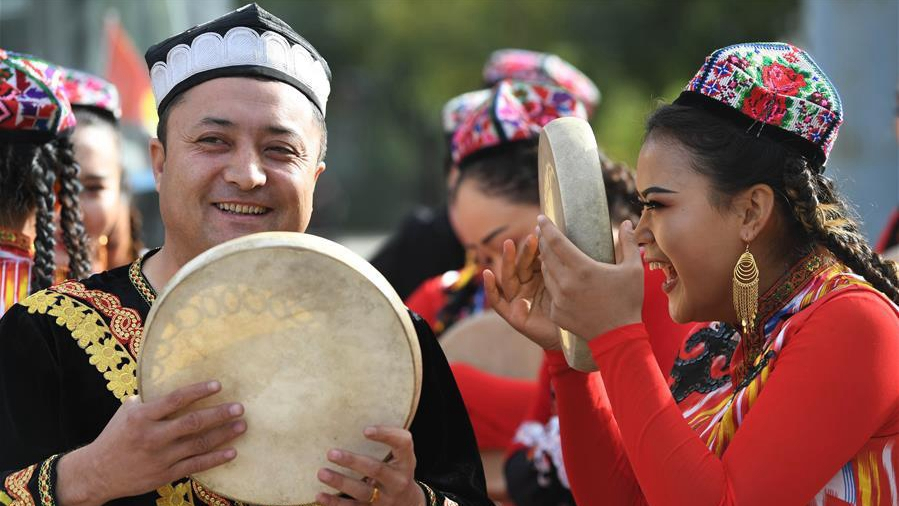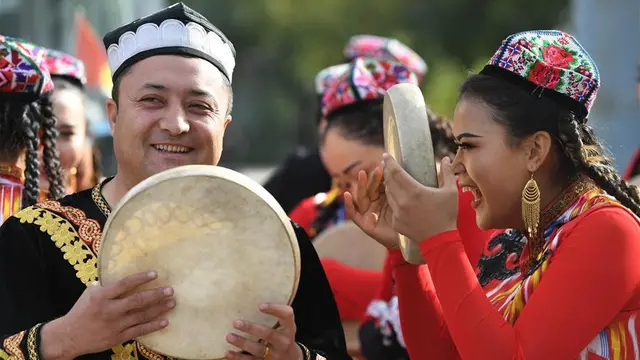
A culture and tourism festival themed on Dolan and Qiuci culture in Awat County of Aksu Prefecture, northwest China's Xinjiang Uygur Autonomous Region, October 25, 2019. /Xinhua
A new report by the Xinjiang University asserts that the population inthe Xinjiang Uygur Autonomous Region has developed at roughly the same rate as the rest of China. Additionally,Xinjiang's population,includingethnic minorities,has maintained a healthy and stable development,and there is no such thing as a "dramatic decline" as described by Adrian Zenz last June.
Zenz,a German "leading expert" on Xinjiang issues, is a member of theVictims of Communism Memorial Foundation, a far-right organization in the U.S. with members that also worked in the CIA.
He started the rumor that there were "over a million" people detained in Xinjiang's vocational training centers,which was cited as almost a common fact when reportingonXinjiang.
The new report proves that his research is based on "disregarded facts,arbitrarily falsified measurement units,and obscures concepts and data sources," and rebuffed his statements.
Lie 1: Natural population growth rate in Xinjiang has decreasedsharply
Zenzstated in his report that "natural population growth in Xinjiang has declined dramatically … between 2015 and 2018," thus the Chinese government was maliciously "suppressing" the Xinjiang's Uygur population.
However,the new report found that from 2015 to 2017,the region's natural population growth rate remained stable above 11 per thousand,according to the data released by the ChineseNational Bureau of Statistics and the Xinjiang Uygur Autonomous Region Statistics Bureau.
Although the region's natural population growth rate "dropped to 6.13 per thousandin 2018," compared to the national natural population growth rate of 3.81 per thousand that year,the growth rate is still "at a relatively high level and in a reasonable rangein 2018," the university report notes, meaning there isno "rapid decline" as Zenz said.
Lie 2: Natural population growth rate plummeted in all ethnic minority regions
According to Zenz, "in 2018, the natural population growth rate plummeted to 4.06 per thousand in all ethnic minority regions of Xinjiang and 2.58 per thousand in Kashgar and Hotan."
Different from what Zenz said, theXinjiang University report finds that in 2018,among the four prefectures in southern Xinjiang where ethnic minoritiesare the predominant population,Kizilsu Kyrgyz Autonomous Prefecture's population growth rate was 11.45 per thousand,with 6.93 per thousandin the Kashgar area,5.67 per thousandin the Aksu area,and 2.96 per thousandin Hotan area, according to the data released by the Statistics Bureau of the Xinjiang Uygur Autonomous Region.
Except for the Hotan area,the natural population growth rate of other areas in southern Xinjiang is higher than the "4.06 per thousand in all ethnic minority regions" alleged by Zenz.
What's more, Zenz's report claimed that, in 2008, the natural population growth rate in Kashgar and Hotan were both "2.58 per thousand,"but the new research proves that the real growth rate was 6.93 per thousand in Kashgar and 2.96 per thousand in Hotan, according to the data released by the local government.
Lie 3: Ethnic Han are the majority, and its population growth rates are much higher
Zenz claimed that population growth rates in Uygur region where Han constitutes the majority were nearly eight times higher than in surrounding rural Uygur regions (in 2018), without giving the source of the data, which is another false claim.
According to the country's official statistics,from 2010 to 2018,Xinjiang's total population rose from 21.82 million to 24.87 million, an increase of 13.99 percent. The ethnic minority population in the region also registered a 22.14 percent growth from 12.98 million to 15.86 million.Among them,the Uygur population rose from 10.17 million to 12.72 million, a 25.47 percentincrease. During that period,the Han population rose from 8.83 million in 2010 to 9.01 millionin 2018, representing a 2 percent growth.
The 25.47 percent growth rate of the Uygur populationis not only higher than that of the entire Xinjiang population, which stands at 13.99 percent,but also higher than the 22.14 percent growth rate of other minority groups and greater than the 2 percent growth rate of the Han population.
Some other false claims in Zenz's report
Xinjiang University's report also exposed other false claims in Zenz's report. For example, when he said, "For 2020, one Uygur region set an unprecedented near-zero population growth target: a mere 1.05 per thousand," in fact, the local government document stated that it was a 1.5 percent growth. This proves that he once again tampered with the figures and statistics in his report.
When it came to the net population change rate for the ethnic Han increasing to 7.42 per thousand, Zenz referred to it as an "estimate," failing to provide supported and concrete data.
Lies and truth: Vocational education and training in Xinjiang
 简体中文
简体中文

